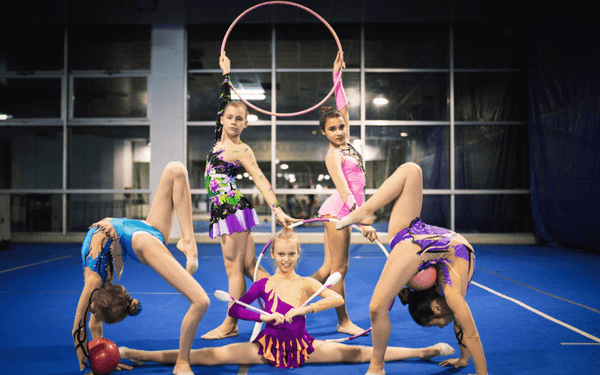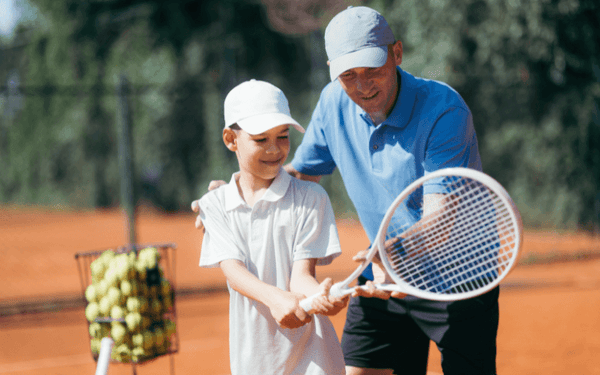Sports are a crucial part of growing up that blends physical health, teamwork, and personal growth. For those of us with a bit more life experience, engaging with the younger generation through sports is a unique way to connect and share timeless values.
Looking back, our own memories of playing tag on the grass, shooting hoops, or doing cannonballs into the pool are reminders of the universal appeal of sports. They've always been there, teaching us about teamwork, grit, and pushing ourselves, even before we knew what those words meant. Yet, the world of youth sports keeps evolving, introducing new games and giving a fresh twist to the old favorites. Keeping up with these changes isn't just about staying relevant, it's about being there for the young athletes in our lives, cheering them on, and fueling their ambitions.
The excitement of seeing a kid make a game-winning shot, swim their fastest lap, or hit their first home run is something special. But supporting them isn't only about applause, it's about recognizing their hard work and the lessons they're learning with every practice and game. It's about reinforcing the good stuff - teamwork, perseverance, discipline - and showing them that we're all in this together.
Let's embrace this opportunity to connect deeply with young athletes, celebrate their achievements, and reinforce the tradition of mutual support in sports.
Top 7 Most Popular Sports for Kids
Soccer: The Global Favorite
Soccer, known as football outside the United States, holds the title of the most popular sport in the world, and its appeal among American youth has surged in recent years. Characterized by its simple objective, to score goals by getting a ball into the opposing team's net without using hands, soccer captivates players and spectators alike with its blend of strategy, skill, and physical endurance.
At its core, soccer is a team sport that emphasizes collaboration, communication, and quick decision-making. Players learn the value of working together towards a common goal, an invaluable lesson that transcends the boundaries of the soccer field. With positions ranging from goalkeepers to forwards, each team member plays a crucial role in the game's dynamics, showcasing the importance of diverse skills and unity.
For young athletes, soccer offers a comprehensive workout that enhances cardiovascular health, improves coordination, and builds strength. Moreover, the sport's global popularity fosters a sense of belonging to a worldwide community, encouraging cultural exchange and broadening horizons.
The accessibility of soccer is another factor contributing to its popularity. All that's needed to start playing is a ball and an open space, making it an inclusive sport that welcomes participants from various backgrounds. This simplicity, combined with the excitement of team competition, makes soccer a compelling choice for youth looking to engage in sports.
As we admire the dedication of young soccer players, it's clear that the sport offers more than just physical benefits. It teaches lessons of perseverance, teamwork, and respect - values that serve individuals well throughout their lives. Watching a soccer match, whether it's a local youth league game or an international tournament, provides a glimpse into the joy and passion that define the sport, making it a cherished part of many young athletes' journeys.

Basketball: A Court of Dreams
Basketball holds a special place in the hearts of many, captivating players and fans with its dynamic pace and the sheer talent it showcases. Originating in the United States, basketball has grown into a beloved sport, with youth leagues and school teams providing a platform for young athletes to shine. The objective is straightforward yet challenging: score points by shooting the basketball through the opponent's hoop while following a set of rules designed to maintain fairness and excitement.
One of the most engaging aspects of basketball is its fast-paced nature, demanding not only physical agility but also mental acuity. Players must constantly be thinking several steps ahead, strategizing their next move while anticipating their opponents'. This fosters critical thinking and problem-solving skills, valuable assets both on and off the court.
Basketball is a sport that emphasizes individual skill within a team context. While each player may have their own unique strengths—be it shooting, dribbling, or defense—the success of the team hinges on how well these talents are integrated. This teaches young athletes the importance of valuing each team member's contributions and working cohesively towards a shared objective.
The physical benefits of basketball are manifold. It is an excellent cardiovascular workout that improves overall fitness, enhances coordination and balance, and develops muscle strength. Additionally, the sport's emphasis on jumping and agility can lead to improved athletic performance in other areas.
Moreover, basketball courts often serve as community hubs, places where friendships are forged, and life lessons are learned. The sport offers a sense of identity and belonging, providing young players with a supportive environment in which they can grow and thrive.
As we watch these young athletes navigate the challenges and triumphs of basketball, we're reminded of the sport's power to inspire and transform. Through every dribble, shot, and pass, basketball teaches resilience, teamwork, and the pursuit of excellence - lessons that resonate far beyond the final buzzer.

Baseball/Softball: America's Timeless Pastime
Baseball and softball are embodying the spirit of tradition and the joy of a simple game played under the open sky. These sports, while distinct, share a common heritage and set of rules that center around hitting a ball thrown by a pitcher and running the bases to score runs. This quintessentially American pastime captures the imagination of youth, offering a blend of strategic play, individual achievement, and team effort.
At the heart of baseball and softball is the concept of teamwork. Each player, whether in the infield or outfield, has a specific role that is vital to the team's success. This structure teaches young athletes the importance of relying on and supporting their teammates, fostering a sense of unity and collective responsibility. Moreover, the rotation of players through different positions encourages versatility and adaptability, skills that are beneficial in all walks of life.
The pace of baseball and softball can vary greatly, from moments of intense action to periods of strategic planning. This ebb and flow allow players to develop patience and focus, as they must remain alert and ready to react throughout the game. The sports also emphasize the value of practice and perseverance; hitting a ball with precision and power is a skill honed over time, reminding players that dedication and hard work can lead to improvement and success.
Physically, baseball and softball engage a range of muscles and require a blend of aerobic and anaerobic activity. From sprinting between bases to the explosive power needed for batting and the agility required for fielding, these sports offer a comprehensive workout that promotes physical fitness and coordination.
The community aspect of baseball and softball is undeniable. Local leagues, school teams, and summer camps bring together players, families, and fans, creating lasting memories and friendships. The sports provide a platform for young athletes to learn about sportsmanship, respect for opponents, and the grace of winning and losing.
As we reflect on the enduring appeal of baseball and softball, it's clear that these sports offer more than just a game; they are a celebration of heritage, community, and the joy of playing together. For young athletes, the diamond is not just a place of competition but a classroom where life's essential lessons are taught through every pitch, hit, and catch.

Football: A Field of Teamwork and Resilience
Football, with its rich history and deep roots in American culture, is more than just a popular sport, it's a showcase of strategy, strength, and teamwork. Played across the United States by youth of all ages, football involves two teams competing to score points by advancing the ball into the opponent's end zone or through their goalposts. The sport is revered not only for the excitement it brings to players and spectators alike but also for the valuable life lessons it imparts to its young participants.
Teamwork is the cornerstone of football. Success on the field depends on the seamless cooperation of all players, each fulfilling a specific role that contributes to the team's overall strategy. This collective effort teaches young athletes the importance of collaboration, trust, and mutual support. Understanding that the achievements of the team supersede individual glory fosters a sense of selflessness and camaraderie among players.
Resilience and determination are also critical aspects of football. The sport is physically demanding, requiring players to push through challenges, recover from setbacks, and continually strive for improvement. This resilience, cultivated on the football field, is a trait that serves young athletes well throughout their lives, instilling in them the perseverance to overcome obstacles and pursue their goals with unwavering dedication.
Football also emphasizes the development of strategic thinking and decision-making skills. Players must quickly analyze situations, adapt to changing conditions on the field, and execute plans with precision. This ability to think critically and make informed choices under pressure is invaluable, equipping young athletes with skills that are applicable in various life scenarios.
The physical benefits of football are substantial, as the sport engages the entire body in rigorous exercise. From sprinting and tackling to throwing and catching, football players improve their strength, speed, agility, and cardiovascular health. The discipline required to maintain peak physical condition fosters a sense of responsibility and work ethic in young athletes.
Moreover, football brings communities together, uniting players, families, and fans in a shared passion for the game. The bonds formed on and off the field are lasting, creating a sense of belonging and pride that transcends the sport itself.
As we admire the dedication and spirit of young football players, it's evident that the sport offers much more than physical activity, it's a comprehensive experience that nurtures character, teamwork, and resilience. Through every play, tackle, and touchdown, football teaches lessons that enrich the lives of those who participate, making it a cherished component of youth sports in America.

Gymnastics: Grace, Discipline, and Strength
Gymnastics stands out as a sport that combines elegance with athleticism, offering young athletes a unique platform to develop not just physical strength but also artistic expression. This discipline involves a series of movements and routines performed on various apparatuses, including the floor, balance beam, uneven bars, and vault for women, and the floor, pommel horse, rings, vault, parallel bars, and horizontal bar for men. Each requires a high degree of skill, precision, and control, making gymnastics a challenging yet rewarding pursuit.
The sport of gymnastics is renowned for its ability to build an extraordinary level of physical fitness. Gymnasts achieve remarkable flexibility, strength, speed, and coordination through their training, which can benefit their performance in other sports and activities. The rigorous routines and exercises also promote discipline and focus, as athletes must dedicate themselves to perfecting their techniques and routines.
One of the most compelling aspects of gymnastics is its emphasis on discipline and self-improvement. Young gymnasts learn the value of hard work, perseverance, and the pursuit of excellence. They are taught to set goals, embrace challenges, and celebrate their progress, no matter how small. This mindset, cultivated in the gym, is invaluable, fostering a sense of self-confidence and determination that transcends the sport.
Gymnastics also teaches young athletes about grace under pressure. Performing complex routines in front of judges and audiences requires not only technical skill but also composure and self-assurance. Gymnasts learn to manage nerves, focus their minds, and deliver their best performance when it counts, skills that are beneficial in all areas of life.
Moreover, gymnastics is a sport that values individual achievement within a team context. While gymnasts perform individually, they often train and compete as part of a team, supporting and motivating one another. This dynamic fosters a strong sense of community and belonging among gymnasts, creating lasting friendships and a supportive network.
The beauty of gymnastics lies not only in the physical feats achieved but also in the character it builds. Through the challenges and triumphs of training and competition, young gymnasts develop resilience, discipline, and a deep appreciation for what their bodies can achieve. These lessons, learned on the mats and apparatuses, equip them with the strength and confidence to face life's challenges with grace and determination.

Swimming: Navigating Success Through Discipline and Endurance
Swimming is not just a vital life skill but also a highly competitive and rewarding sport that engages young athletes across the United States. It encompasses various strokes, including freestyle, backstroke, breaststroke, and butterfly, each requiring specific techniques and strategies. Swimming stands out for its emphasis on personal achievement, discipline, and physical endurance, offering a comprehensive workout that benefits the body and mind.
One of the most significant advantages of swimming is its ability to provide a full-body workout. It strengthens the heart and lungs while toning muscles across the entire body without putting stress on the joints. This makes it an ideal sport for developing overall fitness and physical health. Additionally, swimming enhances flexibility, balance, and posture, contributing to a well-rounded athletic foundation.
Discipline is at the core of swimming as a sport. The dedication required to wake up for early morning practices, adhere to a rigorous training schedule, and continuously strive to improve personal bests instills a strong work ethic in young swimmers. This discipline, cultivated in the pool, translates to other areas of life, encouraging a commitment to goals and a resilience in the face of challenges.
Swimming also promotes mental well-being. The rhythmic nature of swimming laps can be meditative, providing a mental break from the stresses of daily life. Moreover, the focus required to master stroke techniques and breathing patterns enhances concentration and mindfulness. This mental discipline helps young athletes develop the ability to stay calm and focused under pressure, a valuable skill in competitive settings and beyond.
The individual nature of swimming, with athletes competing against the clock to beat their personal records, teaches valuable lessons about self-improvement and personal achievement. Swimmers learn to set goals, celebrate their progress, and cope with setbacks, fostering a healthy sense of self-esteem and personal responsibility. Yet, the sport also has a strong team component, as swimmers often train together and compete in relays, building camaraderie and a sense of belonging.
Community and family play a crucial role in supporting young swimmers, cheering them on at meets and celebrating their achievements. This supportive environment encourages young athletes to pursue excellence, not just in swimming but in all aspects of their lives.
Swimming, with its unique blend of physical rigor, mental discipline, and individual and team dynamics, offers young athletes a pathway to personal growth and achievement. Through each stroke and lap, swimmers learn the value of hard work, perseverance, and the joy of surpassing their own limits, lessons that ripple through their lives, making them well-rounded individuals ready to make a splash in the world.

Tennis: Cultivating Skill, Strategy, and Sportsmanship
Tennis is a sport that elegantly combines physical prowess with mental acuity, offering young athletes a unique arena in which to develop their skills. Played on a rectangular court with a net dividing the competitors, tennis requires players to hit a ball over the net into the opponent's court using rackets, aiming to score points by making the ball unreturnable within the designated boundaries. This sport, with its individual and doubles formats, emphasizes agility, strategic thinking, and endurance, making it a favorite among youth seeking a comprehensive athletic challenge.
One of the key attributes tennis hones is physical fitness. The sport demands quick reflexes, speed, and strength, as players must sprint, change directions, and strike the ball with power and precision. The aerobic and anaerobic workout tennis provides enhances cardiovascular health, muscle tone, and coordination. Additionally, the repetitive nature of racket swings and serves strengthens the upper body, including the arms, shoulders, and back.
Tennis is equally a mental game. Players must constantly think on their feet, anticipating their opponent's next move while devising their strategies. This requires not only focus and concentration but also adaptability, as conditions, opponents, and game scenarios change. The sport teaches young athletes the importance of planning, pattern recognition, and mental resilience, skills that are invaluable both on and off the court.
Sportsmanship is at the heart of tennis. The sport upholds a strong tradition of respect—respect for opponents, officials, and the rules of the game. Young players learn to compete with integrity, handle success and defeat graciously, and appreciate the value of fair play. These lessons in etiquette and humility shape character, fostering individuals who approach life with a sense of honor and respect for others.
Tennis also offers a unique social dynamic. While it can be a highly individualistic sport, especially in singles play, it also provides opportunities for teamwork and social interaction in doubles matches and training sessions. This blend of individual and team experiences allows athletes to develop personal accountability while also learning the value of collaboration and support.
Moreover, tennis is a sport that can be played and enjoyed for a lifetime, transcending age and skill level. This longevity encourages a lifelong commitment to physical activity and offers families and communities a way to bond and engage in healthy, active lifestyles together.
As young tennis players navigate the challenges and triumphs of the sport, they gain more than just athletic prowess. They cultivate a well-rounded skill set that includes physical fitness, strategic thinking, emotional resilience, and a deep sense of sportsmanship. These attributes, developed on the tennis court, equip them to serve up success in all areas of their lives, making tennis a valuable and enriching pursuit for youth athletes.

Which One Do You Choose?
Exploring kids' sports in the USA reveals they're more than just physical activities - they're vital for teaching teamwork, resilience, discipline, and sportsmanship. These sports experiences shape not only healthier bodies but also stronger characters, equipping kids with the tools to handle success and failure, set goals, and collaborate effectively. The impact of sports extends well beyond the playing field, preparing young individuals for life's ups and downs.
Acknowledging their achievements with thoughtful gestures, like personalized gifts that echo their sports passion, can be a meaningful way to show our support. These tokens become lasting symbols of their journey, the lessons learned, and our unwavering belief in their potential.
The realm of kids' sports is woven with lessons of challenge, achievement, and growth. As we cheer from the sidelines, let's not forget the crucial role we play in their sports journey. By offering our encouragement, understanding, and support, we're helping to sculpt the champions of tomorrow in sports and in life. Let's wholeheartedly celebrate every achievement along their path.
Let's celebrate every achievement, big or small, in their sporting journey.

